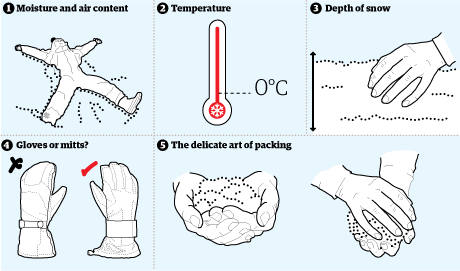
Get ready for wintry war with these instructions
Moisture and air content
Light powder snow is the driest kind, containing lots of air. This snow makes for terrible snowballs because it won't pack – and it won't pack because of its low moisture content. Try looking for a place where you know the snow will be slightly warmer. The heat given off by a house, for example, could make snow just moist enough to make it good for snowballs. Be patient. If all else fails, lie down on some snow for a few minutes; your body heat will begin to melt the snow just a bit, providing that moisture you need to pack it better.
Temperature
The ideal temperature for snowballs is right around freezing. If you know the temperature is around 32F (0C), then don't waste your time scooping snow from near a house; the world's your oyster!
Depth of the snow
If you have more than a few inches, skip the snow on the very surface; your strategy should be to scoop snow out from underneath. Why? It has already been packed together gently, which means less work for you. Even the lightest snow, after an accumulation like this, will be easier to pack after being buried beneath snow layers.
Gloves or mitts?
For a snowball fight, choose gloves. Avoid mittens for a couple serious reasons. If they feel warmer, it's because less heat is escaping them. But a little bit of heat from our hands helps immensely when it comes to packing snow into a snowball (especially when the snow is a little lighter and less moist), so gloves make more sense. Not only that, but have you ever tried to throw a snowball in mittens? It's reminiscent of those childhood nightmares in which you're trying to defend yourself from some villain, but you have absolutely no physical strength.
The delicate art of packing
Scoop up enough snow to fill your cupped hands. You'll inevitably lose a little of it as you pack, and the packing will condense the snow as well. From this cupped position, slowly close your hands together and begin rotating them as if you were trying to trap an insect without killing it. Apply increasing pressure as you rotate your hands into this position, and once they are hiding most of the snow, increase your pressure. Rotate your hands back and forth slightly as you do; you'll hear the muted sounds of friction as the snowflakes compress.
Be careful not to pack too forcefully. If you don't apply enough pressure, the snowball will never be firm, but too much force applied too rapidly will cause the snowball to fall apart. Gradual pressure allows you to withdraw pressure as you feel resistance.
When you feel that the gradual pressure is met with some resistance, withdraw a hand from the snowball. Rotate the ball slightly in your other hand to reveal the rough oval shape of the ball. Position it so that you can round out the oval into a true sphere, and begin pressing again in the same fashion. Repeat until you have the perfect snowball.
If the snowball still lacks the firmness needed for throwing, then start planning ahead. Choosing an inconspicuous location, pack some reserve snowballs. The pressure and hand heat from your packing will cause the snow to release moisture; if left alone, the new moisture of these snowballs will cause just enough firming to make them ideal. When you revisit them, apply just a little packing pressure and then strike.
A perfect snowball should leave its mark. If you have found the right snow and applied that magic amount of pressure, your snowball should leave a clinging mark, physically and psychologically – a brief mark of humiliation on your foe. But there's little time to wallow in self-admiration. You have to start all over again. You're a snowball artist, one of the most romantic of all arts – alternately pure and transgressive but, above all, ephemeral •
No comments:
Post a Comment